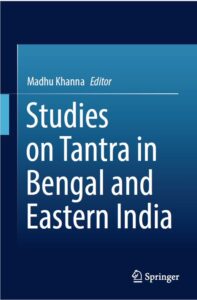New from professor Madhu Khanna is her edited collection Studies on Tantra in Bengal and Eastern India (Springer 2022). This collection brings together both established and emerging scholars in its focus on tantric influences across a region encompassing the states of Assam, Bihar, Bengal, and Nepal. This is a rich field for exploration, as Madhu Khanna points out in her introduction. The diverse religious currents of the region, ranging from Gauḍīya Vaiṣṇavism to Tantric Śākta streams coexisted and cross-fertilized each other. The essays in this collection demonstrate the myriad ways in which adaptations and dialogue between religious traditions influenced and shaped Śākta tantra in Bengal.
Professor Khanna was one of the first contemporary scholars to produce a comprehensive examination of Srikula with her Ph.D dissertation – The Concept and Liturgy of the Śricakra Based on Śivānanda’s Trilogy (Oxford University, 1986) – and her publications include Yantra: The Tantric Symbol of Cosmic Unity (1994), Rta, The Cosmic Order (2004), and Asian Perspectives on the World’s Religions After September 11 edited with Arvind Sharma (2013). She is a former director of the Centre for the Study of Comparative Religion and Civilizations, Jamia Millia Islamia, New Delhi, co-creator of the Centre for Indic and Agamic Studies in Asia (CIASA) and a founding member of the Tantra Foundation, New Delhi. A review of the compendium of tantric ritual manuals she edited in 2014, Śāktapramodaḥ of Deva Nandan Singh can be found here.
Continue reading »

